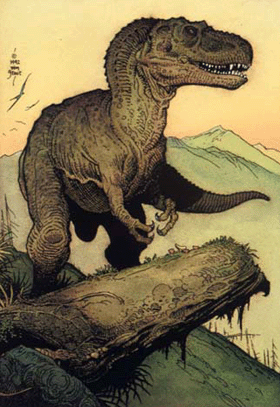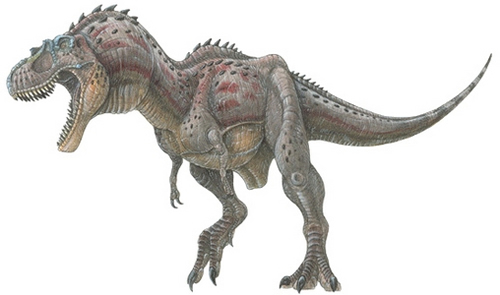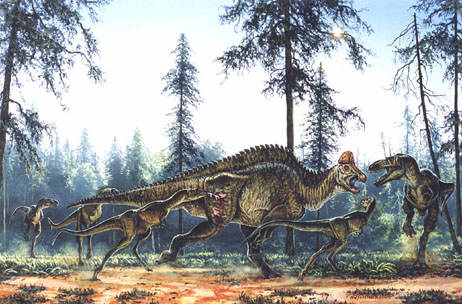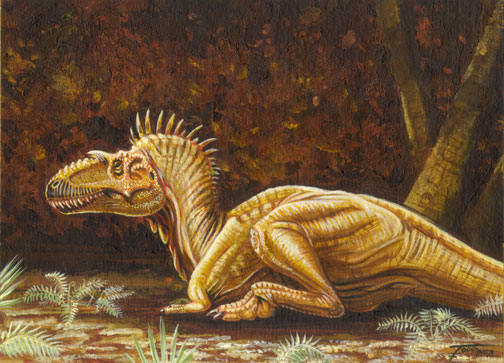Albertosaurus sarcophagus
Homepage > Dinosaur List A - Albertosaurus
sarcophagus
Dinosaur Lists by Letter A B
C D
E F
G H
I J
K L
M N
O P
Q R
S T
U V
W X
Y Z
(al-BER-tu-SAWR-us)
"Alberta lizard"
Describer Osborn, 1905
Also Known As Gorgosaurus, (Lambe, 1914)
Type of Species sarcophagus
Order Saurischia
SubOrder Theropoda
InfraOrder --
Micro-Order --
Family Tyrannosauridae
Size 30 feet (9 meters) in length
Period Cretaceous Late Campanian Maastrichtian, 76-68 million years ago
Fossilsite Canada, US
Diet Bipedal, Carnivore
 Albertosaurus
is a genus of tyrannosaurid theropod dinosaur that lived in western North
America during the Late Cretaceous Period, more than 70 million years
ago, some 8 million years before Tyrannosaurus rex, and 11 million years
before the end of dinosaur time. This dinosaur may have been at the top
of the food chain it its local ecosystem.
Albertosaurus
is a genus of tyrannosaurid theropod dinosaur that lived in western North
America during the Late Cretaceous Period, more than 70 million years
ago, some 8 million years before Tyrannosaurus rex, and 11 million years
before the end of dinosaur time. This dinosaur may have been at the top
of the food chain it its local ecosystem.
Like Tyrannosaurus, Albertosaurus Possessed two-fingered hands and a massive head with many large sized serrated teeth, specialized for cutting meat. This animal was one of the faster runners among the tyrannosaurids, had long, powerful hind limbs. It differed from all other tyrannosaurids in having a wide muzzle.
Albertosaurus was definitely smaller than Tyrannosaurus rex, by about 2 metric tones. A typical adult Albertosaurus measured up to 30 feet (9 meters) in length. Paleontologists estimate that this dinosaur grew to weight as much as 2 tons.
The massive skull of Albertosaurus, was supported by an S-shaped neck, was approximately 3.3 feet (1 meter) long in the largest adults. Wide openings in the skull (fenestrae) reduced the weight of the head while also providing space for muscle attachment and sensory organs. Its long jaws contained more than 60 banana-shaped teeth: larger tyrannosaurids possessed fewer teeth.
All tyrannosaurids, including Albertosaurus, shared a similar body appearance. Typically for a theropod, Albertosaurus was bipedal and balanced the heavy head and torso with a long tail. However, tyrannosaurid forelimbs were extremely small for their body size and retained only two digits. The hind limbs were long and ended in a four-toed foot. The first digit, called the hallux, was short and only the other three contacted the ground, with the third (middle) digit longer than the rest. Albertosaurus may have been able to reach speeds of 25-30 miles per hour.
Gorgosaurus libratus
 The
image to the right shows a sub-adult Gorgosaurus specimen in "death
pose", at The Royal Tyrrell Museum of Paleontology. In 1913, paleontologist
Charles Hazelius Sternberg recovered another tyrannosaurid skeleton from
the slightly older Dinosaur Park Formation in Alberta. Lawrence Lambe
named this dinosaur Gorgosaurus libratus in 1914. Other specimens were
later found in Alberta and Montana. Finding few differences to separate
the two genera, Dale Russell declared the name Gorgosaurus a junior synonym
of Albertosaurus, which had been named first, and Gorgosaurus libratus
was renamed Albertosaurus libratus in 1970. This addition extended the
temporal range of the genus Albertosaurus backwards by several million
years and its geographic range southwards by hundreds of kilometers.
The
image to the right shows a sub-adult Gorgosaurus specimen in "death
pose", at The Royal Tyrrell Museum of Paleontology. In 1913, paleontologist
Charles Hazelius Sternberg recovered another tyrannosaurid skeleton from
the slightly older Dinosaur Park Formation in Alberta. Lawrence Lambe
named this dinosaur Gorgosaurus libratus in 1914. Other specimens were
later found in Alberta and Montana. Finding few differences to separate
the two genera, Dale Russell declared the name Gorgosaurus a junior synonym
of Albertosaurus, which had been named first, and Gorgosaurus libratus
was renamed Albertosaurus libratus in 1970. This addition extended the
temporal range of the genus Albertosaurus backwards by several million
years and its geographic range southwards by hundreds of kilometers.
In 2003, Phil Currie compared several tyrannosaurid skulls and came to the conclusion that the two species are more distinct than previously thought. The decision to use one or two genera is rather arbitrary, as the two species are sister taxa, more closely related to each other than to any other species. Recognizing this, Currie nevertheless recommended that Albertosaurus and Gorgosaurus be retained as separate genera, as they are no more similar than Daspletosaurus and Tyrannosaurus, which are almost always separated. In addition, several albertosaurine specimens have been recovered from Alaska and New Mexico, and Currie suggested that the Albertosaurus / Gorgosaurus situation may be clarified once these are described fully.
Discovery
Albertosaurus was first unEarthed by Joseph Burr Tyrrell in western Canada
in 1884. Albertosaurus was named in 1884 by H. F. Osborn. Many Albertosaurus
fossils have been found in Alberta, Canada and in the western USA. Fossils
called Gorgosaurus turned out to be juvenile examples of Albertosaurus.
Remains of more than thirty individuals have been recovered, providing
paleontologist with a more detailed anatomical composition of this dinosaur.
Albertosaurus sarcophagus Paleo Gallery
Click on images to see more art from artist!



